
TOPICS:
Chatbot for Businesses Chatbot for Website Chatbot for Lead Generation Building a chatbot
Chatbot for Websites – 4 Reasons Why You Must Have a Chatbot on Your Website
Before AI-powered chatbots were largely associated with instant messaging platforms, they made their first appearance on the websites of ecommerce businesses, service providers, and even reputed banking, medical, and educational institutions. So what’s the reason behind the popularity of chat bots for websites?
There are several reasons, actually. Let’s look at some of them.
1. Chatbots for website help you avoid the ‘leaky bucket’.
Are you familiar with the leaky bucket theory? This often-used marketing analogy compares a business’s customer gain and customer loss to a leaking bucket, into which new customer are constantly added to make up for the ones that leave as the bucket ‘leaks’.

A similar analogy can also be applied to the money that is invested in an online business. After setting up their websites, business owners spend a lot of money on mechanisms that promise to bring traffic to the site. Examples include SEO, pay-per-click campaigns, and various online marketing strategies.
Now, these approaches may even succeed in driving traffic to the website in question, but what next? Without ample reason to stay and take the desired actions, visitors will just move on to a different site. This creates a bucket with a rather massive leak – visitors arriving at the website in huge volumes, leaving a little while later, and getting replaced with a fresh stream of visitors. The money spent on all those marketing campaigns is thus effectively wasted.
Online chatbots help websites plug this leak. By starting up a conversation with visitors on the site, bots give them a reason to stick around, understand the business better, look at the products or services it offers, and even make a purchase if possible. The best chatbots for websites are those that are programmed to take every action necessary to guide visitors through the sales funnel. They do this by answering a wide range of questions, offering help with purchase decisions, and pitching discounts and promotional offers on whatever it is that the potential customer is most interested in.
We’ll illustrate this with a sample conversation between Joan, a 35-year-old mother of two, and the online chatbot on a website selling kids’ wear.
Chatbot:
“Hello, and welcome to Shop ABC. I’m your online store assistant. What can I help you with today?”Joan:
“I’m looking for all-cotton onesies for my 1-year-old.”Chatbot:
“Sure thing! Let me share links to some of our bestselling products from that category.”Joan gets a list of links.
Chatbot:
“You can also look at all our cotton apparel for toddlers on this link right here. If you have any questions at all, feel free to ask!”Joan spends some time looking at the products. She knows she has the option of asking the chatbot about sizes, delivery options, and anything else that can help her with her purchase decision. This significantly raises Joan’s chances of shopping with this particular site. The online chatbot helps the website stand out from the crowd, thus proving more effective in capturing Joan’s attention than the marketing strategies that might have brought her to it.
2. Chatbot for websites makes information accessible to all.
The amount of information present on a website becomes immaterial if the average visitor is unable to find it. And in the present-day context, visitors tend to have very short attention spans. As such, websites need to make the task of finding information as quick and simple as possible. Taking the burden of looking for information off visitors’ shoulders is a great way to achieve this. And building chatbots does just that.
Jay, a 55-year-old who needs to get his car serviced in a new city, does not know which auto repair center to go to. He has found a few garages that have websites, but they all seem to have the same generic information. Jay can’t be sure if they’ll have parts that are compatible with his car, or whether the work his car needs can get done in a day’s time. Calling each garage up and asking them seems to be the only way ahead. But then Jay comes across another site, where, in addition to the usual content and links, he also sees a live chat window inviting him to ask questions.
Jay:
“Do you service [Brand] cars?”Chatbot:
“Our repair center is certified for [Brand] repair. You can take a look at our complete list of services and pricing. Please choose what repair service are you looking for…”Jay:
“I also want to know if you stock spare parts for [Brand] cars.”Chatbot:
“We typically have new engine parts, tires, and other accessories compatible with Hyundai cars. If you wish to find out about a specific part, please write your phone number and someone from our team will give you a call.”Jay proceeds to fill out his contact details, and gets the information he needs the very next day.
3. People don’t like downloading apps anymore.
The last few years have seen a sharp decline in the number of mobile app downloads. Apps take up space on your smartphone, while only serving a couple of functions. Plus, people don’t like downloading apps that they’ll use only once – say when there’s a specific discount on shopping from a specific place – and then delete anyway. This makes it all the more important for modern businesses to keep up with the times and create a chatbot for their websites.
Building chatbots for websites helps businesses rope in more customers. People who arrive at these websites are able to talk to the bots to get all their questions answered, and get help with practically any issues they might have. This is way easier than filling up their smartphones with different apps for every online service they use. Plus, they’d have to navigate the app’s options themselves, whereas on the website, they have a friendly chatbot to help them.
4. It pays to have a virtual sales rep on your website.
With effective chatbot development, online chatbots can become the ‘face’ of a website. They can play the combined roles of virtual receptionists, sales reps, and customer support staff. Visitors arriving at a website that has a chatbot don’t need to scour its webpages for special offers or new releases. The chatbot can just pitch these to the visitor, over the course of a natural conversation. Experience shows that people respond well to promotions pitched in this organic fashion. That’s because these feel more personalized than a run-of-the-mill marketing email.
Let’s go back to Joan’s example. Before she can leave the children’s clothing website to check out another online store, the chatbot pitches her a discount.
Chatbot:
“In case you’re interested, we have an end-of-season offer on all cotton products right now. Use [CODE] to get 15% off on your purchase. Thanks for shopping with us!”It’s way likelier that Joan will use this readily available and highly relevant discount coupon, as opposed to something she comes across later in her inbox.
Discover the latest in the world of chatbot development, or get information on building chatbots for your websites, by reaching us right here.